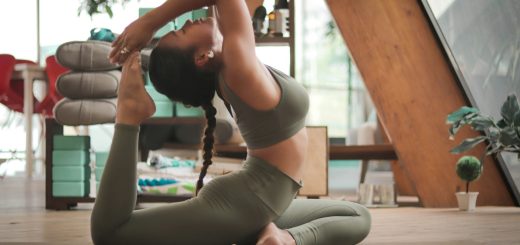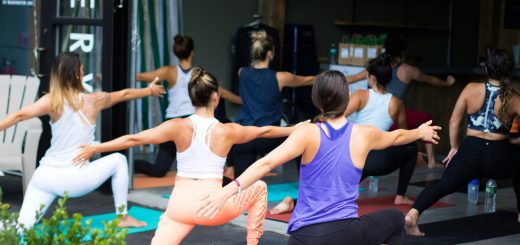Energize & Invigorate: Power Yoga Essence

Hey there, amazing readers! 🖐️ Just a quick note: yes, we know there are a lot of ads here. Trust us, we get it—it’s not the prettiest look, but they help us keep this blog alive and kicking. Those pesky little ads cover the costs of all the behind-the-scenes magic, from hosting and tech stuff to creating content we hope you’ll love.
We’re committed to delivering quality posts, and your support (even just sticking around despite the ads) means everything to us. So, bear with us, and thanks for helping us keep the good vibes rolling. Now, on to the fun stuff! 😉
TRANSLATE BUTTON AT THE END OF THE ARTICLE
A Quick Overview
Power Yoga is a dynamic and vigorous form of yoga that focuses on building strength, flexibility, and mental focus.
It is a modern adaptation of traditional yoga practices, emphasizing a more physical and intense workout.
Power Yoga aims to energize and invigorate the body while also calming the mind, making it a popular choice for those looking to improve their physical fitness and mental well-being.
Understanding the Benefits of Power Yoga
Physical Strength: Power Yoga helps build muscular strength by engaging various muscle groups through challenging poses and sequences.
This can lead to improved overall physical fitness and stamina.
Flexibility: The dynamic movements and stretches in Power Yoga enhance flexibility by lengthening and loosening tight muscles.
This increased flexibility can prevent injuries and improve range of motion.
Mental Focus: Power Yoga requires concentration and mindfulness as practitioners move through poses with control and precision.
This focus on the present moment can help reduce stress and improve mental clarity.
Stress Relief: The combination of physical exertion and mindfulness in Power Yoga can help release tension and stress from the body and mind, promoting relaxation and a sense of well-being.
Weight Loss: The calorie-burning nature of Power Yoga can aid in weight loss when practiced regularly along with a balanced diet.
It can boost metabolism and promote fat burning.
Improved Posture: Power Yoga helps strengthen the core muscles, which are essential for maintaining good posture.
By aligning the spine and improving muscle balance, Power Yoga can help correct posture issues.
Detoxification: The emphasis on deep breathing and sweating in Power Yoga can aid in detoxifying the body by eliminating toxins through the breath and sweat glands.
Boosted Energy Levels: The invigorating nature of Power Yoga can increase energy levels and vitality by stimulating the body and mind, leaving practitioners feeling refreshed and rejuvenated.
Better Sleep: Regular practice of Power Yoga can promote better sleep patterns by calming the mind, reducing stress, and relaxing the body, leading to improved quality of sleep.
Enhanced Self-Awareness: Through the physical and mental challenges of Power Yoga, practitioners can develop a deeper understanding of their bodies and minds, fostering self-awareness and personal growth.
Techniques to Energize and Invigorate
Dynamic Movements: Power Yoga involves flowing from one pose to another with fluid movements, creating a continuous and energetic practice that keeps the body engaged.
Strength-Building Poses: Incorporating poses that target major muscle groups, such as Warrior sequences and Balancing poses, can help build strength and endurance.
Core Engagement: Activating the core muscles throughout the practice is essential for stability and strength in Power Yoga.
Focus on engaging the abdominal muscles in each pose.
Breath Awareness: Syncing movement with breath is key in Power Yoga.
Utilize deep inhales and exhales to energize the body and connect with the present moment.
Balancing Poses: Balancing poses challenge stability and focus, requiring full concentration and engagement of the body to stay centered and invigorated.
Incorporate Sun Salutations: Sun Salutations are a series of dynamic poses that flow together to create a full-body warm-up, stimulating circulation and energizing the body.
Dynamic Transitions: Smooth transitions between poses keep the practice flowing and maintain the energy throughout the session.
Focus on moving mindfully and with purpose.
Use Props: Props like blocks and straps can assist in achieving proper alignment and deepening stretches, enhancing the practice and providing support where needed.
Integrate High Intensity Interval Training (HIIT): Combining HIIT exercises with Power Yoga can amplify the workout, increasing cardiovascular fitness and calorie burn while boosting energy levels.
Cool Down and Relaxation: After an invigorating Power Yoga practice, take time to cool down with gentle stretches and relaxation poses to calm the body and mind.
Importance of Breath in Power Yoga
Pranayama Techniques: Pranayama, or breath control, is fundamental in Power Yoga as it helps regulate energy flow, increase oxygen intake, and promote relaxation.
Ujjayi Breath: The victorious breath, Ujjayi, is commonly used in Power Yoga to create a heating effect in the body, focus the mind, and synchronize breath with movement.
Inhale/Exhale Timing: Coordinating breath with movement is essential in Power Yoga to maintain a steady flow and rhythm throughout the practice.
Inhale for opening movements and exhale for closing movements.
Deep Breathing: Deep, diaphragmatic breathing in Power Yoga promotes relaxation, reduces stress, and oxygenates the body, enhancing endurance and focus during the practice.
Breath Awareness: Paying attention to the quality and rhythm of the breath can help practitioners stay present, calm the mind, and deepen the connection between body and breath.
Breath Retention: Certain Power Yoga poses may involve breath retention to build internal heat, increase lung capacity, and improve focus and clarity.
Practicing Mindful Breathing: Mindful breathing in Power Yoga involves being fully present with each breath, using it as a tool to anchor the mind and body in the present moment.
Breath as a Guide: Letting the breath guide the movement in Power Yoga can create a meditative flow, promoting a sense of ease and awareness throughout the practice.
Balancing Breath and Movement: Finding a balance between breath and movement in Power Yoga is essential for maintaining a steady practice, creating a harmonious union of body and breath.
Breath Awareness Off the Mat: The focus on breath in Power Yoga can extend beyond the mat, helping practitioners cultivate mindfulness and presence in daily life, leading to a more centered and balanced existence.
How Power Yoga Differs from Traditional Yoga
Intensity: Power Yoga is more physically demanding and fast-paced compared to traditional yoga styles, emphasizing strength, endurance, and dynamic movement.
Focus on Fitness: While traditional yoga may focus more on spiritual and meditative aspects, Power Yoga places a stronger emphasis on physical fitness, making it a popular choice for those seeking a workout.
Less Emphasis on Alignment: Power Yoga may prioritize the flow of movements over perfect alignment, allowing for more freedom and creativity in poses compared to the strict alignment of traditional yoga.
Creative Sequencing: Power Yoga sequences are often dynamic and varied, incorporating a wide range of poses and movements to challenge the body and keep the practice engaging.
Adaptability: Power Yoga can be easily modified to suit different fitness levels and preferences, making it accessible to beginners and advanced practitioners alike.
Cardiovascular Benefits: The faster pace and continuous movement in Power Yoga can provide cardiovascular benefits, helping to improve heart health and stamina.
Muscle Engagement: Power Yoga engages multiple muscle groups simultaneously, promoting strength and endurance throughout the body, which may differ from the isolated muscle work in traditional yoga.
Incorporation of HIIT: Some Power Yoga classes may integrate elements of HIIT to increase intensity and calorie burn, offering a more challenging and dynamic workout experience.
Modern Approach: Power Yoga is a contemporary style that adapts traditional yoga practices to suit the needs and preferences of a modern audience, emphasizing physical fitness and mental well-being.
Balanced Practice: While Power Yoga focuses on physical strength and fitness, it still incorporates elements of mindfulness, breath awareness, and relaxation found in traditional yoga, creating a holistic practice that nurtures both body and mind.
Building Strength and Flexibility with Power Yoga
Dynamic Poses: Power Yoga incorporates a variety of dynamic poses that challenge the body and build strength in different muscle groups, such as Plank, Chaturanga, and Warrior poses.
Core Strengthening: Engaging the core muscles in Power Yoga poses and transitions helps build a strong and stable center, supporting the spine and improving overall strength and balance.
Balancing Poses: Balancing poses in Power Yoga require core stability, leg strength, and focus, helping to enhance balance, coordination, and muscular control.
Backbends: Backbend poses in Power Yoga open the chest and shoulders, strengthen the back muscles, and improve flexibility in the spine, promoting better posture and mobility.
Forward Folds: Forward fold poses stretch the hamstrings, calves, and lower back, promoting flexibility in the posterior chain and releasing tension in the body.
Twists: Twisting poses in Power Yoga detoxify the organs, improve digestion, and increase spinal mobility, enhancing overall flexibility and relieving tension in the back and torso.
Hip Openers: Hip-opening poses in Power Yoga release tightness in the hips, groin, and lower back, improving mobility, posture, and relieving discomfort from prolonged sitting.
Strength-Building Sequences: Power Yoga sequences that flow from one strength-building pose to another, such as Sun Salutations, help increase muscular endurance, stamina, and overall strength.
Inversions: Inverting the body in poses like Downward Dog and Headstand in Power Yoga can improve circulation, build upper body strength, and develop core stability and balance.
Consistent Practice: Regular practice of Power Yoga, incorporating a variety of poses and sequences that challenge different muscle groups, is key to building strength, flexibility, and endurance over time.
Flowing Sequences for a Dynamic Practice
Sun Salutations: Sun Salutations are a foundational sequence in Power Yoga that combines forward bends, backbends, and inversions in a flowing sequence, warming up the body and energizing the mind.
Warrior Series: The Warrior series in Power Yoga includes Warrior I, Warrior II, and Warrior III poses, which strengthen the legs, core, and arms while enhancing balance and focus.
Balancing Flow: Incorporating balancing poses like Tree pose, Eagle pose, and Dancer pose in a flowing sequence challenges stability and concentration, promoting core strength and balance.
Core Power Flow: Core-centric sequences in Power Yoga target the abdominal muscles through poses like Boat pose, Plank variations, and Side Plank, building core strength and stability.
Backbend Flow: A sequence of backbend poses like Cobra, Upward Facing Dog, and Camel pose in Power Yoga opens the chest, shoulders, and spine, improving posture and flexibility.
Hip Opening Flow: Flowing through hip-opening poses such as Pigeon, Lizard, and Frog pose in Power Yoga releases tension in the hips, groin, and lower back, promoting flexibility and mobility.
Twisting Flow: Incorporating twisting poses like Revolved Chair, Twisted Lunge, and Revolved Triangle in a flowing sequence detoxifies the organs, improves digestion, and increases spinal mobility.
Inversion Flow: Sequencing inversions like Downward Dog, Dolphin pose, and Shoulder Stand in Power Yoga improves circulation, strengthens the upper body, and enhances core stability and balance.
Full Body Flow: A dynamic sequence in Power Yoga that combines various poses and movements to engage the entire body, from head to toe, creating a comprehensive and energizing practice.
Cool Down Sequence: Ending a Power Yoga practice with a gentle cool down sequence that includes stretches, relaxation poses, and mindful breathing helps the body and mind transition from active movement to deep relaxation.
Enhancing Mental Focus and Clarity
Breath Awareness: Focusing on breath in Power Yoga helps calm the mind, center the body, and enhance awareness of the present moment, improving concentration and mental clarity.
Mindful Movement: Practicing each pose with mindfulness and intention in Power Yoga cultivates a deeper connection between mind and body, fostering a sense of inner focus and clarity.
Setting Intentions: Setting an intention or focus for the practice in Power Yoga can help guide attention, maintain motivation, and bring clarity to the mind throughout the session.
Visualizations: Using visualizations or mental imagery in Power Yoga, such as picturing energy flowing through the body or envisioning strength and flexibility, can enhance focus and concentration.
Mantras: Reciting affirmations or mantras silently or aloud in Power Yoga can center the mind, uplift the spirit, and create a positive mindset for the practice, promoting mental clarity and focus.
Body Scan: Performing a body scan in Power Yoga, where attention is brought to each part of the body sequentially, can increase awareness of sensations, tensions, and areas that require focus or release.
Staying Present: Practicing presence and staying focused on the breath and body in Power Yoga helps prevent distractions, worries, and mental chatter, fostering clarity and mindfulness throughout the practice.
Mindful Transitions: Paying attention to transitions between poses in Power Yoga, moving with grace and awareness, can enhance the flow of the practice and promote mindfulness and mental focus.
Eyes Soft and Gaze Intention: Softening the gaze and maintaining an intention in Power Yoga, such as focusing on a point or drishti, can help steady the mind, improve balance, and deepen concentration.
Gratitude Practice: Cultivating gratitude during Power Yoga by reflecting on blessings, achievements, or moments of joy can shift perspective, enhance positivity, and promote mental clarity and focus.
Finding Balance and Inner Peace
Grounding Poses: Grounding poses like Mountain pose, Child’s pose, and Warrior poses in Power Yoga establish a sense of stability, connection to the earth, and inner peace.
Mindful Movement: Moving mindfully and with intention in Power Yoga cultivates a sense of presence, awareness, and balance between body and mind, fostering inner peace and harmony.
Restorative Poses: Incorporating restorative poses like Corpse pose, Legs Up the Wall, and Reclining Bound Angle pose in Power Yoga promotes relaxation, rejuvenation, and deep inner peace.
Meditation and Visualization: Introducing meditation and visualization practices in Power Yoga, such as guided imagery, mindfulness meditation, or loving-kindness meditation, can calm the mind and nurture inner peace.
Breathwork: Utilizing breathwork techniques like deep breathing, Ujjayi breath, or alternate nostril breathing in Power Yoga can soothe the nervous system, reduce stress, and promote a sense of inner calm.
Nature Connection: Practicing Power Yoga outdoors or visualizing natural elements like water, trees, or mountains during the practice can foster a connection to nature and cultivate a sense of peace and harmony.
Yoga Nidra: Incorporating Yoga Nidra, or yogic sleep, in Power Yoga can induce deep relaxation, reduce anxiety, and promote inner peace by guiding practitioners into a state of conscious relaxation.
Gratitude Practice: Cultivating gratitude through reflection, journaling, or affirmations in Power Yoga can shift focus from stress and negativity to appreciation, fostering inner peace and contentment.
Self-Compassion: Practicing self-compassion in Power Yoga by acknowledging limitations, celebrating progress, and treating oneself with kindness and understanding can nurture inner peace and self-acceptance.
Silent Contemplation: Taking moments of silent contemplation or reflection in Power Yoga to be present with thoughts, emotions, or sensations can deepen self-awareness, promote inner calm, and cultivate peace of mind.
Tips for Beginners in Power Yoga
Start Slow: Begin with shorter sessions and gradually increase the duration and intensity of your Power Yoga practice to build strength and endurance over time.
Focus on Form: Pay attention to proper alignment and technique in Power Yoga poses to prevent injuries and maximize the benefits of the practice.
Listen to Your Body: Honor your body’s limits and modify poses as needed in Power Yoga to avoid strain or overexertion, respecting your individual needs and abilities.
Stay Hydrated: Drink water before, during, and after your Power Yoga practice to stay hydrated and replenish fluids lost through sweat.
Warm-Up and Cool Down: Always warm up with gentle stretches and cool down with relaxation poses in Power Yoga to prepare the body for movement and promote recovery.
Breathe Mindfully: Focus on deep, steady breathing in Power Yoga to oxygenate the body, calm the mind, and stay present throughout the practice.
Be Patient and Persistent: Progress in Power Yoga takes time and consistent practice, so be patient with yourself and stay committed to your journey of growth and self-improvement.
Seek Guidance: Consider attending beginner-friendly Power Yoga classes, watching instructional videos, or working with a qualified instructor to ensure proper guidance and support

The Enlightenment Journey is a remarkable collection of writings authored by a distinguished group of experts in the fields of spirituality, new age, and esoteric knowledge.
This anthology features a diverse assembly of well-experienced authors who bring their profound insights and credible perspectives to the forefront.
Each contributor possesses a wealth of knowledge and wisdom, making them authorities in their respective domains.
Together, they offer readers a transformative journey into the realms of spiritual growth, self-discovery, and esoteric enlightenment.
The Enlightenment Journey is a testament to the collective expertise of these luminaries, providing readers with a rich tapestry of ideas and information to illuminate their spiritual path.
Our Diverse Expertise 🌟
While our primary focus is on spirituality and esotericism, we are equally passionate about exploring a wide range of other topics and niches 🌍📚. Our experienced team is dedicated to delivering high-quality, informative content across various subjects ✨.
To ensure we provide the most accurate and valuable insights, we collaborate with trusted experts in their respective domains 🧑🏫👩🏫. This allows us to offer well-rounded perspectives and knowledge to our readers.
Our blog originally focused on spirituality and metaphysics, but we’ve since expanded to cover a wide range of niches. Don’t worry—we continue to publish a lot of articles on spirituality! Frequently visit our blog to explore our diverse content and stay tuned for more insightful reads.






